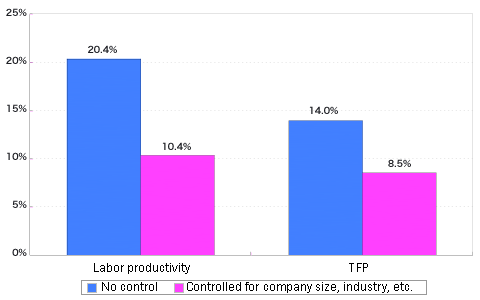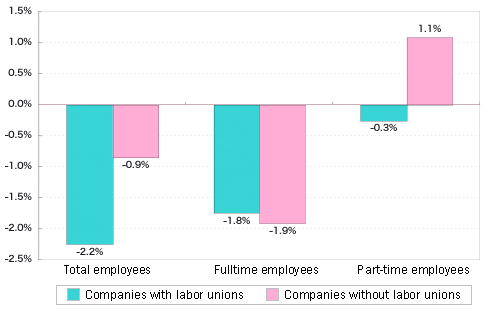Declining trend of union density
As aggregate demand declines and employment conditions continue to deteriorate in the aftermath of the global economic crisis, interest in productivity improvement has somewhat waned at the moment. In the medium- to long-term horizon, however, increasing productivity is a crucially important policy issue for Japan as its population is aging fast and certain to decline further given the persistently low fertility. It will re-emerge as one of the focal points for economic policy once the economy has recovered. In what follows, I would like to discuss the relationships of how productivity is affected by the presence of labor unions and the management of human resources, drawing on findings from my empirical research.
Along with long-term employment and seniority-based wages, the formation of firm-based unions has been one of the characteristics of Japanese-style employment practices. When a nationwide "productivity movement" was launched in the post-war high growth period with a focus primarily on manufacturers, labor unions took part and strived to enhance productivity through labor-management cooperation. Currently, labor union representatives are participating in a recently launched "service productivity movement" as a core member.
In the meantime, the rate of union membership in Japan has been on a consistent decline, down from the peak of above 50% shortly after the end of the Second World War to 18.1% in 2008, according to the Basic Survey on Labor Unions conducted by the Ministry of Health, Labour and Welfare. Japan is not alone in observing this trend as union density has also been declining in other major countries including the United States, the United Kingdom, Germany, and France.
Labor unions and productivity
The relationship between unionization and productivity has long been an issue of significant interest to scholars in labor economics and industrial relations specialists. Thus, there exist a large number of preceding studies both in Japan and abroad. Labor unions may help enhance productivity by serving as a collective voice for workers to enhance labor-management communication. At the same time, however, it has been pointed out that labor unions can also be a monopoly bargaining agent, which may have a negative impact on productivity. Many empirical studies have shown that the estimated effects of unionization on productivity vary significantly in the U.S. and Europe, ranging from positive to negative. The tentative consensus at present is that the presence of a labor union at a worksite has no or a modest positive impact on productivity. *1 In the U.S. in particular, it is perceived that the productivity enhancing impact of labor unions is far too small compared to the wage-boosting impact, resulting in a net negative impact on corporate profitability.
In Japan, a series of studies have been done on the effects of labor unions on productivity but the findings are divided with some pointing to positive and others pointing to negative effects. Those preceding studies have their limitations in one way or another. In almost all of these studies, targets for analysis are limited to manufacturers, whereas studies using firm-level data tend to be limited in the number of companies sampled. Meanwhile, those using total factor productivity (TFP) data are almost non existent. Furthermore, many of the preceding studies examined the effect of labor unions on productivity levels, but not on productivity growth.
In consideration of these observations, Morikawa (2008) analyzed the relationship between the presence of labor unions and productivity, using large volumes of firm-level data covering both the manufacturing and non-manufacturing sectors. *2 The method of analysis used for this study is quite simple. Controlling for certain firm characteristics such as company size and industry, I measured differences in productivity between companies with unions and those without. Contradictory to the findings in preceding studies in the U.S., my analysis found that the presence of labor unions has a statistically significant, positive impact on the level and growth of productivity (labor productivity, TFP) and its magnitude is non-negligible, boosting the productivity level by 10% to 20% and annual productivity growth by about 0.5 percentage points ( figure 1 ).

On the other hand, the number of employees decreased more sharply for companies with labor unions than for those without, mostly attributable to the difference in the attrition rate among part-time employees, rather than fulltime employees ( figure 2 ). According to the Basic Survey on Labor Unions, the union density for part-time workers was 5.0% in 2008, which although higher than the 3.3% level in 2005, was still extremely low. This indicates that Japanese labor unions have not reached the point of realizing higher productivity in the form of incorporating part timers and other non-regular workers. How firm-based labor unions deal with part-time employees and other non-unionized workers is closely related to the question of how to balance the need to improve growth prospects for the Japanese economy against the need to rectify income inequality.

Importance of human resource management
Needless to say, the productivity of an organization is significantly affected by the quality of human resources and employee motivation. Recent micro-level studies on productivity have gone beyond merely measuring the productivity impacts of research and development (R&D) activities or information technology investments, focusing more on underlying factors such as corporate governance and internal incentive systems. That is, a number of studies have been conducted to examine the relationship between human resource management - i.e., incentive compensation plans, in-house training, team formation, flexible work allocation, etc. - and productivity. Many of these studies have shown that good human resource management has a positive impact on productivity.
My analysis mentioned above does not incorporate data on labor-management relations other than those on labor unions. Thus, I cannot exclude the possibility that companies with labor unions show higher productivity because these companies happen to utilize excellent human resource management. Should it be the case, the presence of a labor union might be acting as a proxy variable for good human resource management. The existing statistical data would not provide sufficient information to delve into this question. Thus, it is necessary to devise ways to collect appropriate data, for instance, combining data collected by conducting a questionnaire survey with information obtained through interviews. As part of its research project, "Study on Intangible Assets in Japan," RIETI has been conducting a survey incorporating those factors and its findings are anxiously awaited.
As one of the topical issues in terms of this context, the relationship between work-life balance (WLB) and productivity can be cited. Bloom and Van Reenen (2006) examined this point based on the results of surveys of companies in the U.S., France, Germany, and the UK. They found that although a significant positive relation exists between favorable WLB and high productivity, this relationship disappears when the quality of management is controlled for. Then, based on this finding, they concluded that while there is not sufficient ground for the government to mandate companies to implement measures for WLB, the cost of such measures is justifiable for individual companies because there is no negative relation between WLB and productivity. *3 This is an important research agenda particularly in considering ways to improve the productivity of service industries with a high proportion of female workers. RIETI is vigorously pursuing research on this issue under the project entitled "International Comparison of Measures to Improve Work-Life Balance and Consideration of Challenges Facing Japanese Companies."


